 Back to selection
Back to selection
Shutter Angles
Conversations with DPs, directors and below-the-line crew by Matt Mulcahey
“The Horse Needs to Go to the Right”: DP Mihai Mălaimare Jr. on The Harder They Fall, Assembling a COVID-Era Lens Package and On-Set Safety
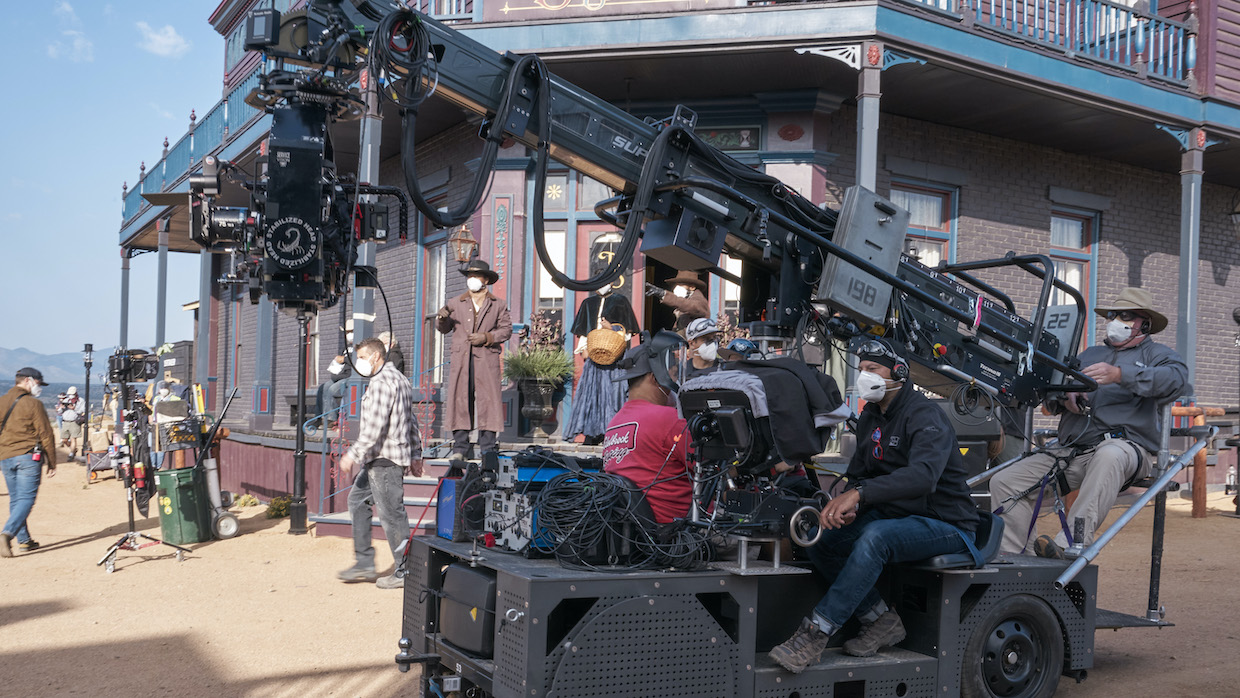 On the set of The Harder They Fall (photo by David Lee, courtesy of Netflix)
On the set of The Harder They Fall (photo by David Lee, courtesy of Netflix) There are moments in the new Netflix western The Harder They Fall that glean inspiration from Sergio Leone or the paintings of Kadir Nelson, but the film’s style—replete with split screens, zooms and precisely arranged widescreen compositions—was also shaped by cinematographer Mihai Mălaimare Jr.’s choice of lunchtime perch.
“Because of COVID, we couldn’t all eat together, so we would each pick our own spots. I always ate up on the balcony of one of the sets,” said Mălaimare Jr. “The crew always joked that was why we have so many high angle shots in the movie, because I would be on the balcony and realize, ‘Actually, it looks pretty good from here….let’s bring in the crane.’”
Pitting an assortment of real-life Western figures against each other in a fictionalized tale of revenge—director Jeymes Samuel describes it as his version of assembling The Avengers —the film finds the Nat Love gang (led by Jonathan Majors) seeking retribution against the rival Rufus Buck outfit (headed by Idris Elba). With The Harder They Fall hitting Netflix this week, Mălaimare Jr. (The Master, Jojo Rabbit) spoke to Filmmaker about using Peckinpah as a benchmark for excess, employing a cornucopia of off-the-beaten-path lenses and the tragedy on the set of Rust, which shared some of the same New Mexico locations.
Filmmaker: You have a picture of your lens list from The Harder They Fall on your Instagram feed, and we could probably do this entire interview just on this wild assortment of glass. The Panavision T Series and the Panaspeeds are the main sets, but then you have Panavision lenses I wasn’t familiar with at all, like variable squeeze lenses. You also have listed two mysteriously named “58mm and 85mm Mihai” lenses. How did this package come together?
Mălaimare: The process was very interesting. In June of last year, Jeymes called me and was like, “Please tell me you’re available. We are starting in a few weeks.” So, I had to figure out how to put the gear list back together. [Note: The film was initially set to shoot in March of last year before being shut down due to the pandemic]. Since it was a Western, I thought we’d definitely have to go anamorphic. In my mind there was no way around 2.40. You have to go widescreen.
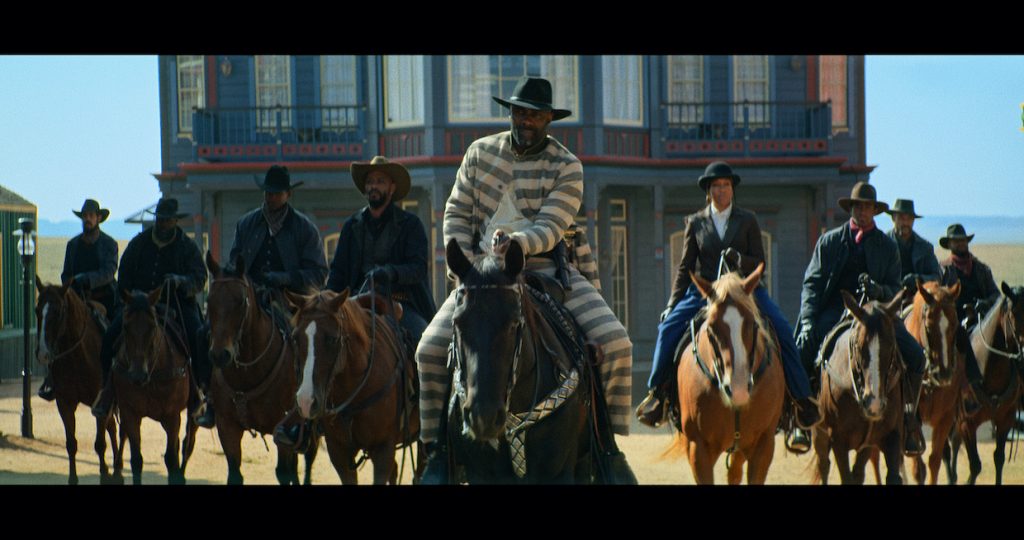
Filmmaker: You have shots with Elba’s gang where there are nine people on horseback. So, yeah, widescreen makes sense.
Mălaimare: Yeah, you gotta go widescreen. I called Panavision right away. We were going to use the DXL2. I’d used that a few years ago on The Hate U Give with Ultra Panatars and Auto Panatars, but unfortunately those lenses were stuck all over the world. When COVID hit and production stopped, a lot of the gear pretty much stayed in place. Everybody thought it would be only a few weeks or maybe a month or two. So, those lenses were technically available, but not really, because they were out of the country. In a moment of panic I went to Panavision to meet with [VP of Optical Engineering] Dan Sasaki just to figure out what other options we had. Sometimes we make the mistake of going by numbers and the pixel count—that said, I didn’t want to go 2x anamorphic with the DXL, even if Dan was giving me numerous examples of movies that did so. He told me that even though you are losing a lot of resolution, it still works, but I was just fighting and fighting it. I went to Panavision a few times trying to figure out what the options were in-house, and after one of those visits Dan called me a few days later and said, “You’ve got to come and see this.” It was the T Series, but Dan did a 1.85x custom squeeze, which gained me something like 600 or 700 pixels—I don’t remember the count exactly, but it was a quite substantial number. He also told me that because they did this custom squeeze there was a certain detuning that happened within the lens, and now the T Series was not as sharp and they fell off more, and a lot of other interesting things. I saw them and fell in love with them right away. So, that’s how we got to the T Series as our main set.
The anamorphic lenses, even if they open to a T2.3, never look good wide open, so you have to stop down a little bit. Realistically, the widest you can go would be a T3.5, if not a T4. We had a lot of night exterior scenes in the script and to light a night exterior for a T4, you need a lot of light. Also, the wide anamorphic lenses are great sometimes, but sometimes they distort too much. That’s why I always try to pair an anamorphic set with a spherical set and the Panaspeeds seemed like the right choice. Not only can they be shot wide open at T1.4, but I really like the way they looked, especially at night.
I also love to have some specialty lenses. The 58mm and the 85mm [“Mihai” lenses] were my personal still photography Helios lenses that we rehoused with Dan. It’s funny, because I had those lenses as a kid when I was 15 and started taking still photographs and I hated them with so much passion. (laughs) I really wanted a Nikkor lens.
Filmmaker: Those are the lenses with the swirling bokeh?
Mălaimare: Exactly, but what was also really interesting about the T Series with the 1.85x custom squeeze is that they had that swirl as well. We shot a lot of portraits on those, and also on the 135mm variable squeeze, which is such a unique lens.
Filmmaker: How does that work? You can change the anamorphic squeeze on the lens itself?
Mălaimare: Yes, from 1.25x to 1.5x. It worked really well for certain portraits where we wanted to squeeze it even more. It was great for the split screen shots, when you have to fit six or seven portraits in one frame.
Filmmaker: There’s a 270-840mm Panavision anamorphic zoom on the list. What’s the longest you went on that lens?
Mălaimare: We went 840mm quite a lot. We used it for a lot of shots like looking down the road in the towns, POVs through windows and all that. I remember putting that zoom on B camera and using it so much because it looked so good. I’m normally not a fan of zooms, but when they look good, they look good. It’s great to have super long lenses when you have such a vast open space.
Filmmaker: Different groups of lenses on your list have different color designations. What do the different colors mean?
Mălaimare: We came up with that color coding just to differentiate the lenses right away. It helped the camera assistants as well. Using old lenses is so hard on the camera assistants. With new lenses, a lot of them have the same diameter. The old lenses are all over the place and you need a different donut and accessories for each one. So, we came up with that color coding to know that, for example, all the Panaspeeds would work with a certain type of accessory. Also, visually, we could look at it and tell right away which were the specialty ones and which were the workhorses.
Filmmaker: Did some of them just day play for specific shots or scenes? How many did you have for the run of show?
Mălaimare: I’m always trying to help production, so I hate to get a lens for three months and then use it once. So, we started with the idea that we would day play some of them, but once we started using them three days in a week it was like, “We better just keep them with us.” Luckily, we were able to have all of these with us all of the time.
Filmmaker: At the start of each day, did you already have a pretty good idea what lenses were going to play in which shots, or did you have some freedom to play around and just try to find cool things on the day?
Mălaimare: There was some freedom. There were certain scenes where we really wanted to have storyboards because they were so complicated and there were so many moving parts, like the train scene or the final act or anything involving stunts and a lot of characters. We kind of knew initially how we wanted to capture a scene, but there was a lot of leeway to watch the rehearsals and see what was best suited for that scene. It’s great when you are prepared, but there’s nothing wrong with changing the plan on the day.
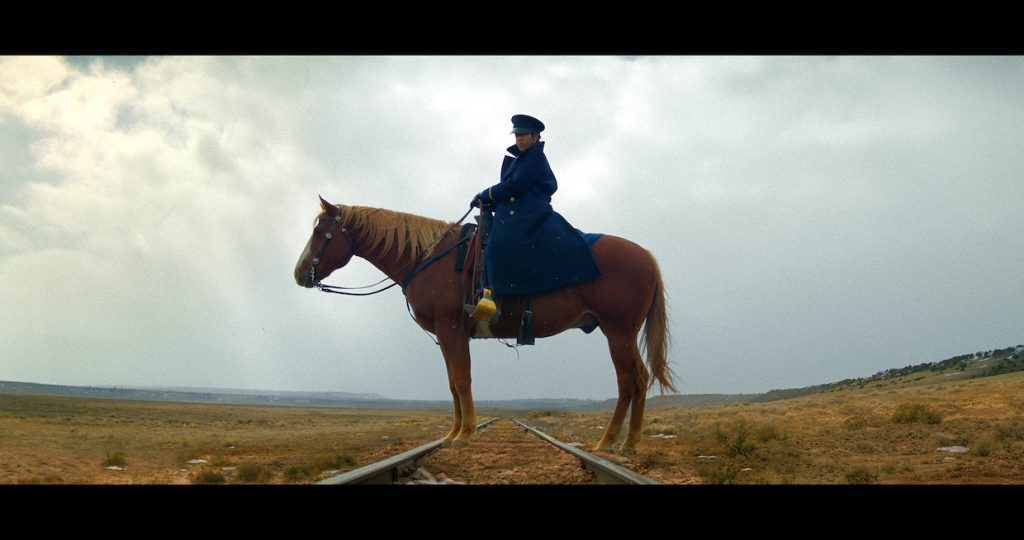
Filmmaker: Let’s talk a little about references. Jeymes has mentioned Kadir Nelson as an inspiration. There’s a shot of Regina King on the train tracks that echoes Nelson’s “Harlem Equus.” What else did you look at?
Mălaimare: Being from Europe and from Romania, Sergio Leone is a big part of our cinematic pride, and Jeymes and I spoke about him. There were so many movies we discussed. We watched The Wild Bunch together. I still remember as a kid the first time I saw The Wild Bunch and the first time I saw Butch Cassidy and the Sundance Kid. Those two stayed with me for so long and for so many reasons. So, we watched The Wild Bunch to try to figure out if our movie was too violent.
Filmmaker: That’s a high bar, Peckinpah.
Mălaimare: Right. (laughs) It was like, “Okay, we’re not as bad as we thought.” Especially with a genre like the Western, you want to pay tribute, but also to come up with something new. There are certain things you cannot run away from and we embraced those, like the fact that there is a certain framing for a cowboy hat, or that using anamorphic with drastic falloff will force you into framing your characters dead center. But I think the most important visual reference was indeed Kadir Nelson. I kind of enjoy not having movie references for specific images, even though I do sometimes. I feel like a static image, like a still photograph or a painting, is much more interesting as a reference, because even if a frame from a movie can have the same quality, it’s still designed to work in conjunction with other frames, whereas a painting or a photograph is meant to be looked at for hours [on its own]. That [“Harlem Equus”] painting is the perfect example. Jeymes showed it to me and said, “This is how [King’s character] Trudy should look on the train track.” We all had that image on our phones and we’d be like, “No, the horse needs to go to the right a little more to match it.”
Filmmaker: One of the things I loved about The Harder They Fall is the character introductions. One of my favorite Westerns is Leone’s Once Upon a Time in the West, which has legendary character intros. That first scene where Idris Elba’s character is introduced reminded me of the Henry Fonda intro in that film.
Mălaimare: That scene was one of the most complicated. We were trying to be so ambitious. We originally designed that to play as a single shot, starting with a drone shot from really far away, then we would do a VFX takeover [to blend into] a Steadicam shot inside the house, then play the rest of the scene in one Steadicam move. We shot it that way but, of course, when you get into editorial, the downside of doing that is that there’s no way you can adjust the length of the scene. It ended up needing to be cut down, so we actually went back when we had a few days of reshoots and re-shot that opening scene. We kept a few of the moves [from the original shoot] but went back and covered the scene more classically with static shots and close-ups.
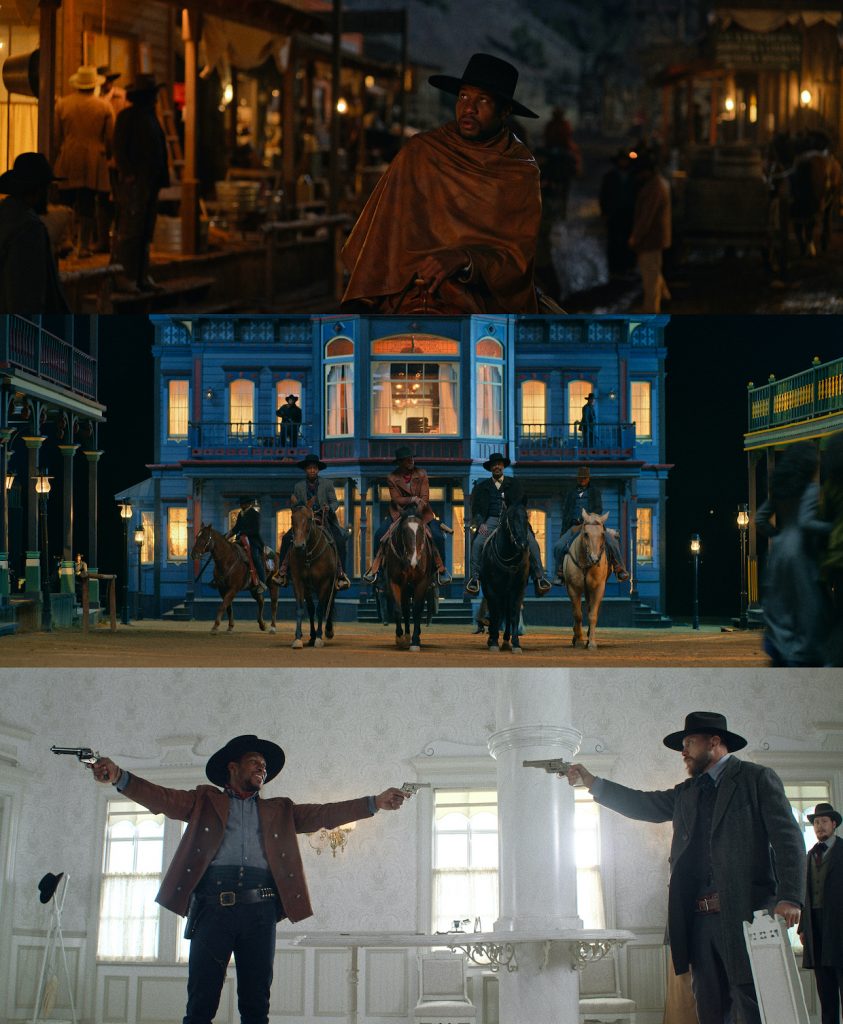
Filmmaker: The movie is set largely in three distinct towns—Douglastown, the more affluent Redwood, then the town of Maysville for a bank heist scene. I love the production design of Maysville, where literally everything in the frame is white.
Mălaimare: That was so great. It was mentioned in the script, then our amazing production designer, Martin Whist, did some concept drawings and it evolved as Jeymes came up with even more ideas, like having white gravel and only white horses. I remember laughing so hard when I heard about it. I thought it was the greatest idea ever. When you’re in prep and trying to figure out how you want things to look, I tend to go with the flow and not worry about how we’ll achieve things. I like to leave that for later. On the day, our amazing DIT,e Eli Berg, who I’ve used for the last 12 years, did a good job of keeping the highlights in check with all that white. That scene is one of the few moments in any premier that I’ve been a part of where a set itself gets applauded. (laughs)
Filmmaker: There is night exterior work in Douglastown and Redwood. How did you approach lighting those street scenes in each?
Mălaimare: The concept was that Redwood is lit by streetlights and torchlights, whereas Douglastown is lit by fire barrel. In Douglastown we did a wet down—something I very rarely do, but I think the mud and the reflections in that almost frozen water on the ground paid off. The main discussion about Redwood was to make it look really rich. I remember Jeymes telling us to imagine it as if it’s a photograph printed on high-gloss paper. Working with the art department, we had so many streetlights and that helped a lot. I joked with my gaffer Jay Kemp that it’s probably the most lights I’ve ever used for a night exterior, but I think it played and made Redwood pop more than Douglastown.
Filmmaker: A lot of the town exteriors were built. Were you mainly using those interiors as well or were you on stage for some of them?
Mălaimare: All of them were practical interiors.
Filmmaker: Even the train scene?
Mălaimare: Yeah.
Filmmaker: Let’s talk about a few specific shots. Before the final showdown, there’s a cable cam shot that starts on the second floor of this ornate room in Redwood looking over Elba’s shoulder and then the camera passes through the window and flies all the way down the length of the town’s Main Street and ends on a close-up of Jonathan Majors.
Mălaimare: Jeymes had that idea in his mind way before we started prepping. We had to remove that window [practically on set], then add it back [in post via VFX] and of course there was a big crane behind the church [at the end of the street behind Majors] that was supporting the cable cam. The only problem we had with that shot was the wifi—we kept losing signal to the 1st AC’s wireless focus and our monitors when we were like 10 feet away from Nat at the end of that shot. In the end, we got it by moving a few antennas around and turning off a few devices, but it’s quite amazing that was the only problem we had for that shot.
Filmmaker: I don’t know how deep of a stop you were at or what focal length, but that seems like a difficult focus pull. It’s a very fast move into a very tight close-up.
Mălaimare: It was pretty difficult. I also realized that we had to be as wide as possible to start, but then I wanted to be as tight as possible when we reached Nat. So, I also snuck in a zoom as we were flying on the cable cam. We were starting at a 24mm behind Rufus in the first frame and ending on a 68mm when we were close to Nat. So, I made that pull even harder for them.
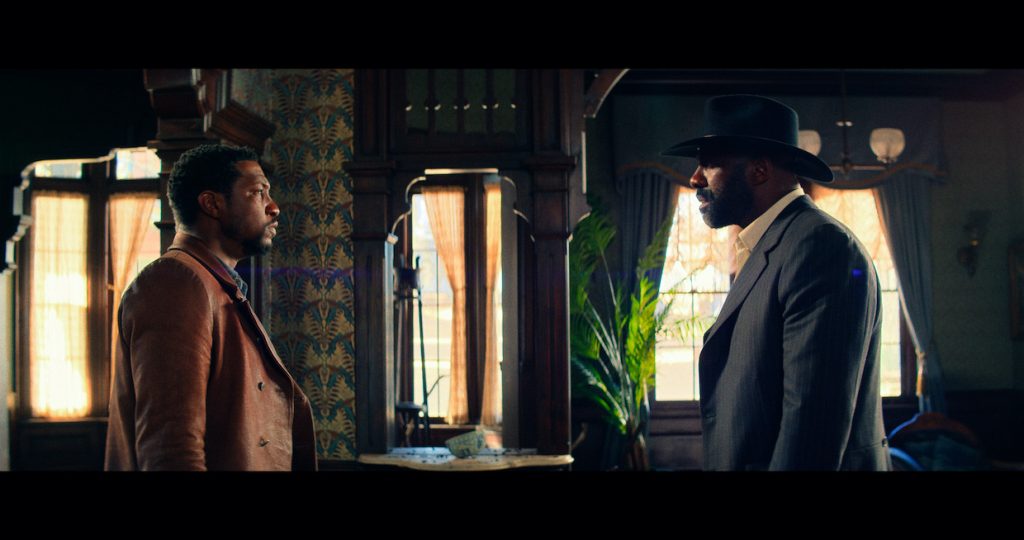
Filmmaker: The final confrontation between Rufus and Nat is the first time they’re in the same shot together. They share a few brief scenes before that, but they are never in the same frame until they square off at the end.
Mălaimare: That was a very cool idea of Jeymes’s. Except for a quick moment before Nat gets into the mansion, that scene was also the first handheld in the movie. We realized that if we succeeded in keeping the style classical and not going handheld, then when we do actually go handheld it shows intention. We also split the style of the coverage. Rufus is in control, so his coverage should be on dolly, while Nat’s coverage should be handheld. When they both come into frame, then we got back to our main approach, which was on the dolly. A lot of times, especially in a scene like that, you want to cross-cover ]where you shoot both sides of the scene simultaneously], but when you mix things and want to cover one actor handheld and one on dolly, it starts to get a little complicated. It ended up working really well. It’s harder on everybody, but it gives the actors an amazing opportunity to act together instead of acting with somebody [offscreen if you only shoot one side of the scene at a time].
Filmmaker: That’s all I’ve got for you. Is there anything I didn’t ask that you wanted to talk about?
Mălaimare: Yeah, we should talk about what happened in New Mexico [on the set of Rust, where director of photography Halyna Hutchins was killed]. That’s such a tragedy. I was shooting some inserts on another project and Jeymes texted me. That [church] is the exact same location where we shot our second scene of the movie. It’s heartbreaking, but it’s infuriating at the same time, because I feel that production failed on so many levels. We’ll see what all happened [when more information comes out] but it was quite a shock. It really made me think. We were in the same place and using a lot of guns. So, I was just trying to go back and figure out if we ever put ourselves or somebody else in a situation like that, and realized that our production was so safe. You thank God for amazing producers and amazing 1st ADs. We did have a lot of VFX muzzle flashes in this movie and we did rehearse always with a rubber gun and so on.
Filmmaker: Even if all real guns are banned from set and all muzzle flashes and those sorts of things are done with CGI, I do think it’s a greater issue than that. To me it ties back into some of the things that IATSE was fighting to get into place in terms of more reasonable hours and turnaround. This is a tragedy that just happened to involve an on-set prop gun, but I think there’s a bigger issue around the pace and pressure under which movies are made and how that can relegate safety to being a secondary concern.
Mălaimare: You’re absolutely right. If your crew is not well-rested, you cannot expect them to always make the right decisions. It’s part of the discussion of how to make a safe set. And yes, you need to sleep enough hours. There’s no way around it. It’s unbelievable that happened and I don’t know the answer or exactly what needs to be done, but it’s a wake-up call for all of us.
Matt Mulcahey works as a DIT in the Midwest. He also writes about film on his blog Deep Fried Movies.
